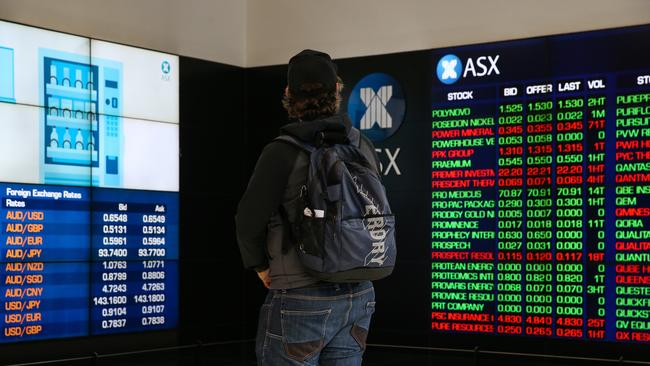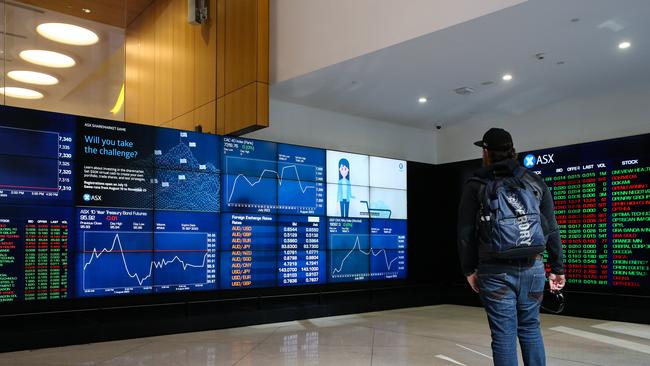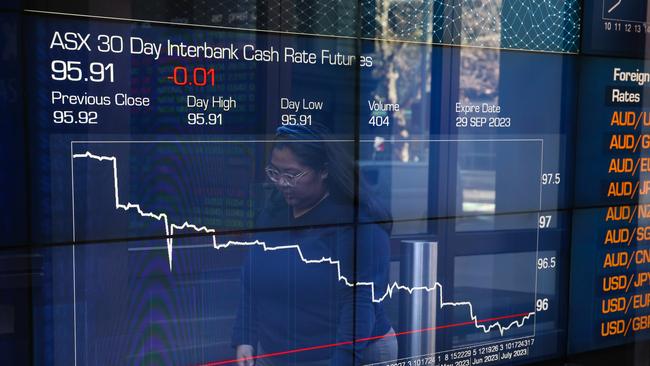Australian dollar plunges after weak jobs numbers
The Aussie dollar has fallen to its lowest level in nine months after new unemployment figures were revealed, causing havoc in the sharemarket.
Business Breaking News
Don't miss out on the headlines from Business Breaking News. Followed categories will be added to My News.
The ASX200 has suffered another decline after tough day half way through the earnings season, while the Aussie dollar dropped significantly after the jobless rate jumped to 3.7 per cent.
The Aussie market fell by 49 points or 0.7 per cent to 7146 on Thursday, with eight of the 11 sectors recording losses.
Industries recorded the steepest declines while the real estate sector was the best performer.
It comes as the Australian dollar dropped to a nine-month low of US63.64 cents following an unexpectedly weak jobs report, while 3-year bond yields also fell a few basis points.

The dollar has declined 0.7 per cent in the session and more than 5 per cent since the start of August. Before the release of the ABS unemployment figures for the month of July, the Aussie stood at US64 cents.
Australia’s jobless rate jumped to 3.7 per cent, up from 3.5 per cent, reinforcing expectations that the RBA is on an extended hold.
Markets had been expecting an increase to 3.6 per cent.
“Cracks are finally appearing in the employment data, and that should clear up any doubt over whether the RBA are done hiking,” City Index senior analyst Matt Simpson said.
“[The Reserve Bank is] done at 4.1 per cent with persistently weak data from China and easing from the People’s Bank of China adding to the case of a peak rate.”

But the ASX is still being shaken by concerns over a weakening China economy and a soft lead from Wall St.
China’s economy fell to just 0.8 per cent in the three months ending in June – equal to a 3.2 per cent annual rate, which would be among China’s weakest in decades, the Associated Press has reported.
Market Analyst Tony Sycamore said the data coming from China coupled with the national employment rate influenced the Australian sharemarket on Thursday.
“A softer-than-expected Australian labour force report has come to the aid of the beleaguered Australian stock market today, which plunged 89 points (-1.2%) shortly after the opening bell, following a weak lead from Wall Street,” Mr Sycamore said.
“Nonetheless, the fall in employment, which follows hot on the heels of Tuesday’s tepid wages data, was viewed as good news today as it provides another reason for the RBA to stay on hold in September.
“A thought latched onto by the ASX200, which this month has been caught in a tidal wave of renewed concerns over the Chinese economy, higher yields, and a softer Australian dollar.”

Mr Sycamore said he expected the market will continue to respond to the fall in the Aussie dollar in the coming days.
“While a fall in the AUD/USD boosts the earnings of our exporters, it weighs on the earnings of importers and negatively impacts offshore investors in the Australian stock market who aren’t fully currency hedged,” he said.
“A prompt rebound back above the 200-day moving average at 7230ish is needed to negate the risks of the ASX200 extending its decline to range lows 7050/00 area.”

The most significant underperformer was Core Lithium, a battery metals developer, experienced a notable drop of 24.77 per cent.
This decline followed a $100m share placement at 41c.
“The company (and shareholders) hope the placement will enable the company to complete its near-term projects while preserving balance sheet flexibility,” Mr Sycamore said.
Real wstate company Domain Holdings fell 7.84 per cent to $3.76 after it reported profits fell 19 per cent to $26.1m as the RBA’s rate hiking cycle took the sting out of the property market and listings.
Shares in Telstra, which announced its 2022-23 results on Thursday morning, fell 2.2 per cent despite the firm posting a $2.05bn profit.
Originally published as Australian dollar plunges after weak jobs numbers




